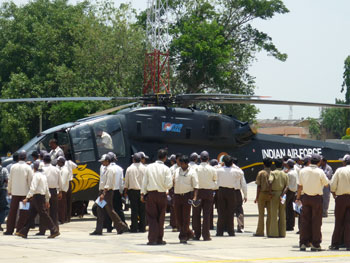INDIAN ARMED FORCES CHIEFS ON
OUR RELENTLESS AND FOCUSED PUBLISHING EFFORTS

SP Guide Publications puts forth a well compiled articulation of issues, pursuits and accomplishments of the Indian Army, over the years

I am confident that SP Guide Publications would continue to inform, inspire and influence.

My compliments to SP Guide Publications for informative and credible reportage on contemporary aerospace issues over the past six decades.
- Prime Minister witnesses 'Bharat Shakti' – a Tri-Services Firing and Manoeuvre Exercise in Pokhran, Rajasthan
- Interim Defence Budget 2024-25 — An Analysis
- Union Defence budget 2024
- Prime Minister Modi Commemorates Indian Navy Day in a Grand Ceremony
- Prime Minister Modi Flies in the LCA Tejas
- New Chapter in India-Italy Defence Ties
- Airpower beyond Boundaries
HAL reaches out to Indian electronics industry
 August 19, 2014: With several development projects on its hands, as opposed to a skewed order book of license-produced aircraft, Hindustan Aeronautics Ltd (HAL) is making a concerted effort to ramp up cooperation with India's electronics industry, both large firms as well as (and especially) small and medium enterprises (SMEs) to build a more viable production and supply base for its currently and future projects. In HAL's words, it is a proactive approach for a stronger aeronautics ecosystem. With life cycle costing set to be paradigmatic in all future procurements and assessments, HAL has deduced that avionics will be crucial to life cycle costs of aircraft systems it develops (These would include communications, flight controls, electrical systems, sensors, utilities management etc and mission roles like navigation and guidance, surveillance , stores/weapons delivery, command & control).
August 19, 2014: With several development projects on its hands, as opposed to a skewed order book of license-produced aircraft, Hindustan Aeronautics Ltd (HAL) is making a concerted effort to ramp up cooperation with India's electronics industry, both large firms as well as (and especially) small and medium enterprises (SMEs) to build a more viable production and supply base for its currently and future projects. In HAL's words, it is a proactive approach for a stronger aeronautics ecosystem. With life cycle costing set to be paradigmatic in all future procurements and assessments, HAL has deduced that avionics will be crucial to life cycle costs of aircraft systems it develops (These would include communications, flight controls, electrical systems, sensors, utilities management etc and mission roles like navigation and guidance, surveillance , stores/weapons delivery, command & control).
Through a series of meetings with industry that commenced this month, HAL has made a clarion call to industry to step up and get involved for a field of opportunities in avionics system design, avionics LRU design & development, electronic functional module development, board design, fabrication & assembly, test rig /integration rig development, crucial sensors development, data bus and display devices, software development, integration & testing.
"Presently over 40% of an aircraft's cost is on avionics," says a top HAL official who was part of recent presentations. HAL has set out a roadmap, populating it with opportunities and specific areas where cooperation and initiative is desperately necessary. The focus will be on line-replaceable units (LRUs), sensors eg. Radar, Inertial Navigation, RADALT, IR, display systems eg. MFD , SMFD, HUD, Smart HUD, data bus eg. 1553B, AFDX, ARINC, 1760, Video bus STANAG, DVI, PAL, Control, Command & Communication eg. HOTAS, VHF/UHF , SDR , SATCOM, Electronic Warfare eg. RWR, SPJ, CMDS, MAWS and high performance computers eg. Mission, Display & weapons computers.
While indigenous LRUs available already include radio altimeter, IFF, VOR/ILS, TACAN, MFD, SMFD, HUD, 1553B, ARINC, V/UHF Communication systems, radar warning receivers, high performance computers, mission computers, air data computers, AFCC, solid state flight data recorders and digital map generators, HAL has outlined that there continues to be a major dependency on foreign OEMs for fire control radars, inertial navigation, software defined radio, electro-optic sensors (LDP), health monitoring systems and, crucially, auto pilot.
HAL currently has three dedicated R&D centres focused on electronics and avionics: the Hyderabad-based Strategic Electronics R&D Centre for communications, radars, radio navigation, embedded computers, etc, the Bangalore-based Mission and Combat R&D Centre for integrated avionics systems, application software, mission computers, etc. and the Korwa-based R&D Centre for flight data recorders, display and cockpit control systems, etc.
HAL has decided to mince no words with industry. Outlining its experience in dealing with Indian electronics industry, it says that capability exists in electronic product development – including complete systems and modules like including cockpit displays, computers, recorders, RF units, air data units, video modules, interface units, etc, manufacture for prototype and production batches, test rigs and other ground support equipment (GSE) development and fabrication, software services and engineering services, HAL still holds that continuous support to vendors (“Hand holding”) is needed for specific domain knowledge, quality requirement, testing, documentation, etc. "HAL is required to interface between the vendor and certification agencies, regularly gets products and test Rigs developed and supplied through Indian vendors: Complete electronic subsystems have been developed by Indian vendors for many projects (Jaguar DARIN-II and DARIN-III Upgrades, IJT, ALH, LCH, etc.), and almost all test/integration rigs are developed and supplied by private vendors.
HAL lists the challenges faced by SMEs as (1) domain knowledge and translating user requirements into design parameters, (2) insufficient knowledge of the certification requirements and process, (3) inadequate availability of facilities (especially for processing and testing), (4) long development cycle and production in small batches spread over years, (5) competitive pricing, tight schedule, stringent advance payment, (6) long term supply and product support concerns and (7) inadequate experienced man-power and dependency on individuals.
The company has therefore provided a workable roadmap starting this month, proposing vendors’ meets held at Bangalore and other HAL locations to familiarize the vendors with the current and futuristic requirements and procedures and to provide a forum for interactions on common issues.





